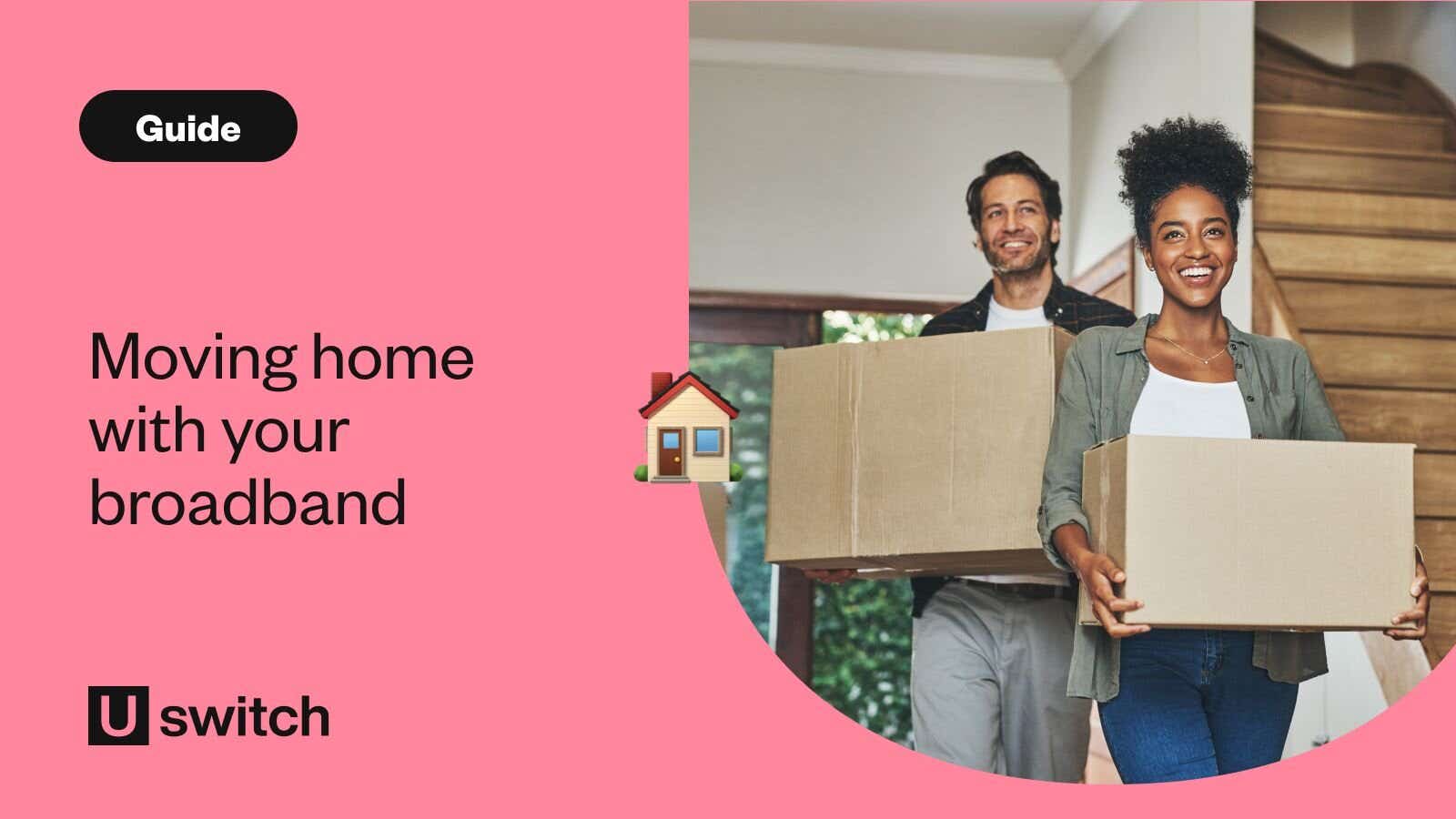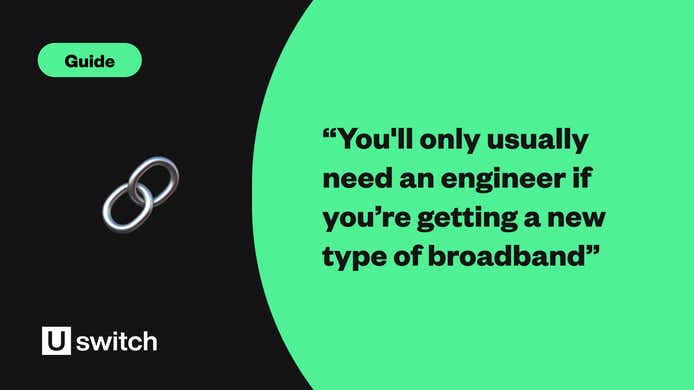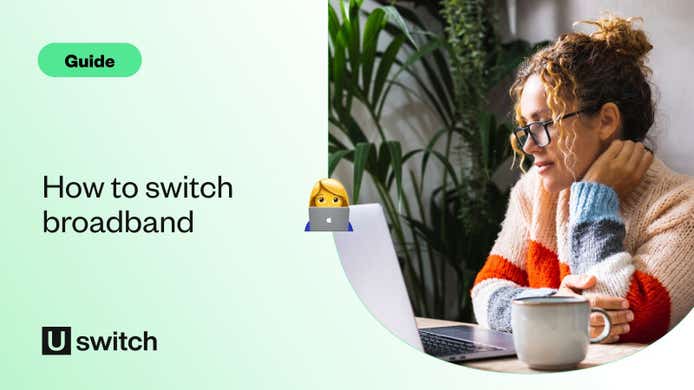When moving home, you’ll probably have a long list of things to do. There are boxes to pack, moving vans to hire and a load of bills and paperwork that you need to organise before moving day.
While sorting your broadband and moving house at the same time might seem stressful, in most cases, it’s actually fairly straightforward.
This guide will help you decide whether it's best to transfer your existing broadband package to your new property, or change to a new provider.
Things to consider about your broadband
When moving house, broadband isn't always the first thing on your to-do list. But organising all the services, bills and subscriptions you'll need is something that's better sorted before moving in.
Our research revealed that the one million Britons who moved home in 2020 waited an average of eight days for their broadband to be connected. Additionally, one in three were forced to use up all their mobile data allowance while they waited to be connected.

Broadband in your new home
Out of contract? Check for better broadband at your new address with our range of competitive deals.
What to consider about broadband when moving home
There are a few things you should find out about your broadband contract when you’re moving home:
Are you under contract with your current provider? Is the fixed-term ending soon?
Has your provider raised prices above the rate of inflation while you're in contract with them? If so, you could be free to leave without penalty.
Are you happy with your current package and broadband provider?
Does your current provider operate in the area you are moving to?
If so, does your current provider service the specific property you're moving to? (this is especially important when moving into a flat)
If your current provider doesn't have coverage in the area you're moving to, which providers do?
Can your current provider bundle products like TV, landline and broadband together into one seamless monthly payment?
If you think any of these issues need addressing, use the Uswitch broadband postcode checker to see which broadband packages are on offer in the area you're moving into.
Make sure you take a look at our moving house checklist to ensure you have everything you need in the lead-up to your big move.
Broadband and moving home: what are your options?
Most broadband providers will allow you to take your broadband service with you when you move, as long as they have coverage in that area — although a small charge may apply.
Some providers might also require you to start a new contract with them, which means committing to another 12, 18, or 24 months with that specific broadband provider once you move to your new address.
This isn't always a bad thing, because securing a low monthly rate from your provider is ideal. However, if they're unable to secure you a good price, or indicate that there will be price jumps, it would be worth looking at other broadband deals for your new home.
Transferring your internet from house to house
It may not always make sense to change. It could be worth staying with your current provider and simply transferring your broadband if:
- It has coverage in your new area
- You are happy with your broadband package
- You are still under contract with it and don't want to pay any termination or cancellation costs
Cancelling or switching your broadband
This is where it gets a little more complicated. When moving house, you might want to switch to a new broadband provider if your current service isn’t available in the area you’re moving to.
If you want to switch, you should first compare broadband deals to find out what services and deals are available in the area you're moving to. Then, by following the steps with your new provider, you can notify your old one that you're moving house and switching from them.
You can also compare cheap broadband deals in particular by toggling the '£0-25' filter on our results tables, if you're looking for a low-cost internet service.
But unfortunately, it’s not always that simple.
If you're still within your initial contract period, you'll have to pay an early termination fee to cancel, even if you can’t continue that service at your new address.
The amount you would need to pay to cancel varies depending on your provider, the length of time remaining in your contract and any subscription services.
Not ready to switch just yet?
If you still have some time left on your current broadband contract, feel free to sign up for an end-of-contract reminder with Uswitch.
Just add your contract end date and address, and we'll send you a notification when you're ready to switch to a new provider without charge. We'll even throw in some examples of new customer deals available at your address.
Broadband renewal reminder
Tell us your contract end date and we'll remind you to save
Contract end date
Get reminders to find a better deal when your contract is ending. We may use your address and current provider to show you relevant deals. Terms and conditions apply. Privacy notice.
How to move your current broadband connection to a new house
If your current provider is available in your new property, then they will do most of the work for you. Here's what you need to do to get the process up and running.
Notify your current provider with your move-in date well in advance of the day. This will help them set up the new connection for when you need it.
Your provider will schedule the switch-off of your current home's broadband connection on a date of your choice.
In the mean time, unless any technical issues arise, your provider will plan to activate your new home broadband on your agreed date.
If the broadband connection has previously been installed in your new home by a former resident, your provider will deliver a new Wi-Fi router and instructions to set it up yourself.
However, if the connection hasn't been installed at your new home yet, an engineer may need to come and set it up. This may come with an installation cost.
Once the setup is complete and your broadband is activated, you'll be able to complete the rest of your current contract with no changes.
Moving home with different providers
Depending on your broadband provider, your process for moving house with them might be different. Here's a rundown of the process each of the UK's most popular broadband providers uses to move your connection over.
Sky
Moving home with Sky
For customers of Sky Broadband, moving home is also a simple matter of confirming your new address and moving date with Sky at least two weeks in advance, since it uses the same Openreach broadband networks as BT.
Depending on the network coverage at your new address, you may be able to upgrade your broadband during your Sky home move, or you may have to downgrade to a slower service.In either case, you may incur an activation fee to set up your Sky Broadband at your new address. Find out more and arrange your move with the Sky moving home hub.
Sky TV moving home
If you’re also a Sky TV customer there could be some added complications, as you will likely need to arrange an engineer visit to install and set up a satellite for your Sky TV.Certain Sky customers may be able to self-install if all the necessary equipment is already in place in your new home. However, if you’re a Sky Q TV customer, an engineer visit is always required.The cost of a Sky TV engineer visit is currently:
£50 on a weekday
£65 on a weekend
Virgin Media
Moving home with Virgin Media
Unlike BT and Sky, Virgin Media runs on its own cable network. It's less widely available than some other providers, at 52% national coverage compared to 97% of the country that can access Openreach's slower superfast fibre network.Compare broadband in my areaIf you are able to transfer your existing broadband account to your new address you’ll need to contact Virgin Media directly and provide the following details:
Your account number (found on your bill)
Your current and new address
Your contact number
Your moving date
Your preferred installation date
If the new property has already had Virgin Media installed previously, you can use a QuickStart self-install pack to avoid engineer charges.
And if you're moving to a property that doesn't have access to its network, you won't have to worry about paying early exit fees too. As long as Virgin knows you're moving house, it will let you cancel your contract with them fee-free.
BT
Moving home with BT broadband moving house
BT’s moving home service takes care of most of the hassle for you. All you need to do is fill in your home phone number and account number, along with your new address, postcode and move-in date, and BT will do the rest (provided it can service your new property).
Since BT is so widely available across the UK (97% superfast fibre coverage), it’s highly unlikely that you’ll have any trouble accessing its services from your new home.
Keep in mind, however, that there may be charges if there is no BT master socket in your new property or you need a new line installed. This can end up costing as much as £130.
BT recommends giving at least two weeks' notice before your move in order to avoid any loss of service.
TalkTalk
Moving home with TalkTalk
TalkTalk requires a minimum of 14 days notice in order to transfer your broadband service to your new home, and can work towards a moving date that’s a maximum of three months away.
TalkTalk charges £60 to transfer your broadband to a new address, and all you need to do is start a chat within the My Account section of the TalkTalk website and provide them with your new address and your moving date.
Vodafone
Moving home with Vodafone
To take your Vodafone broadband with you change address, you’ll need to give them at least 30 days' notice.
You’ll need your Vodafone account number or landline number, then you just need to call 191 free from your Vodafone mobile or 0333 304 0191 from any other phone to arrange the transfer.
EE
Moving home with EE
To move your broadband with EE, you can select the option ‘moving home’ within your My EE account.
If this option isn’t currently available on your account page you can contact EE on 0800 079 8586 and select option three for EE Home Broadband.
Which broadband provider has the fastest installation?
According to our recent research, nearly all major broadband providers had customers waiting at least a week to connect. Plusnet took the longest time, at almost ten days, while Virgin Media customers had to wait just under seven.
| Provider | Days* |
|---|---|
| Plusnet | 9.9 |
| TalkTalk | 9.4 |
| BT | 8.6 |
| EE | 8.1 |
| Sky Broadband | 7.7 |
| Vodafone | 7.3 |
| Virgin Media | 6.6 |
*Average days without a connection
Uswitch broadband provider reviews
Read our expert reviews of all of the UK's biggest broadband providers.
How to switch broadband providers
If you're out of contract with your provider when you plan to move home, switching to a new broadband service is likely much cheaper than paying the transfer charges to stay with your current broadband provider.
In addition, broadband prices are almost always cheaper for new customers than when you re-contract as an existing customer, so switching broadband when moving home could be the way to go.
One exception to the above is if you're a Virgin Media customer. If you're in the middle of a Virgin Media broadband contract and you're moving to a property that isn't on its network, the provider will no longer charge you an early disconnection fee.
If you think switching is the way to do it, you can compare a range of different broadband speeds and prices on Uswitch. Just input your postcode on one of our deals pages and filter your results to the requirements you need.
How to switch broadband
Switching is easier and simpler than you think. Learn how to find a cheaper or faster tariff (or both!) with our step-by-step guide.
Here's a quick taster of some of the broadband deals on offer on our site:

- £75 voucher
- Most Popular Broadband Provider of the Year
Setting up broadband in your new home
If you're getting a new broadband connection installed at your new property, it can sometimes take a bit of time to arrange for an engineer to visit and set the equipment up—especially if you've changed your provider during your move.
No upfront cost broadband
Browse our range of broadband deals with no upfront cost.
Here's some helpful advice on what to do when waiting for your broadband to be connected to your new home:
How long does it take to set up internet in a new home?
Setting up internet access in a new house usually takes around two weeks. If a working broadband line is already installed on the property, getting internet access could be as simple as plugging in your new router when you arrive.
If you do need a new line installed, however – either for a new provider or a new service such as fibre or cable broadband – an engineer visit can take up to two weeks to arrange. If this is the case, it's worth noting that you may need to pay installation fees to connect your new home to the internet. Our recent broadband statistics reveal one in six (15%) broadband users paid between £20 to £29.99 for line installation in 2022 (Uswitch survey of 2,003 broadband users, August 2022).
| Region | No installation fees | Up to £19.99 | £20 - £29.99 | £30 - £39.99 | £40 or more |
|---|---|---|---|---|---|
| UK | 74% | 1% | 15% | 9% | 1% |
| East Midlands | 78% | 1% | 16% | 6% | 0% |
| South West | 80% | 2% | 13% | 6% | 0% |
| North East | 76% | 1% | 16% | 7% | 0% |
| Greater London | 56% | 1% | 29% | 12% | 1% |
| Scotland | 78% | 1% | 15% | 6% | 1% |
| Northern Ireland | 58% | 3% | 21% | 18% | 0% |
| East of England | 75% | 1% | 14% | 9% | 1% |
| South East | 79% | 2% | 11% | 7% | 1% |
| West Midlands | 68% | 1% | 15% | 15% | 0% |
| Yorkshire and the Humber | 76% | 1% | 12% | 11% | 1% |
| Wales | 80% | 0% | 16% | 1% | 3% |
| North West | 78% | 1% | 11% | 9% | 1% |
How do I get internet while waiting for installation?
How do I get internet while waiting for installation?
If you're confident you have enough mobile data allowance on your phone contract, you might be able to temporarily rely on your smartphone for more online activities, such as sending emails or watching a TV show.
Likewise, if you need to use a bigger device like a laptop in that time, you can tether it to your smartphone to get online via a mobile internet connection. But once again, this uses up a lot of mobile data. So only rely on this option if you know you won't have to pay an expensive fee for going over your limit.
The most effective (but also most expensive) option is to sign up for a monthly rolling mobile broadband contract. This will provide you with a mobile dongle that will connect to the mobile internet available in your area, and act like a router for your devices. All you'll need to do is plug them into a normal socket in your home, and cancel the contract for free when your installation date eventually rolls around.
How to get internet in a new build
The process of getting internet access in a new build is much the same as that for other properties.
However, in some new-build flats and neighbourhoods, there are what are known as 'micro-monopolies'. These are where broadband services for the entire building or street are exclusively provided by one provider.
While this does limit your choice, these are often high-end broadband services which will give you access to ultrafast or even full fibre broadband.
For example, Hyperoptic is often an exclusive broadband provider for new-build flats in urban areas. Hyperoptic full fibre broadband speeds can reach up to 1Gbps, which is over 15x the national average broadband speed of 64Mbps.
Hopefully, switching broadband when you move will be quick and simple, leaving plenty of time to stress about all the other things you need to do before moving day. Good luck.
Broadband and moving home FAQs
What should I do with my old routers?
If you're moving your broadband connection or cancelling your contract, you'll likely be getting a new router for your new home.
Providers often will tell you how you can send the router back or recycle it. But if you don't get any instructions from your provider, you can find out what to do with our broadband router recycling guide.
When should I tell my provider that I am moving?
If you know the date you'll be moving, it's good to let your provider know about 30 days in advance. Some providers only require a couple of weeks, but the more prepared you are with these things the better - and the smoother your transition to a new connection should be.
Can I get fibre at my new property?
Fibre broadband is a lot more available than you might think. In fact, more than 96% of UK properties can access Openreach's 'partial-fibre' network, which offers superfast internet speeds up to 70Mbps.
However, full fibre is a slightly different question. While it's a lot faster than partial-fibre, it's also less widely-available across the country, and only about one-third of UK homes can currently get it.
Use our fibre broadband postcode checker to see whether your new property can access full fibre.





